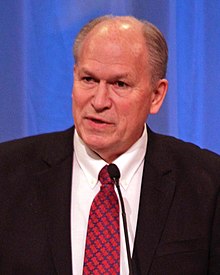List of governors of Alaska
| Governor of Alaska | |
|---|---|

|
|
| Residence | Alaska Governor's Mansion |
| Term length | Four years, renewable once |
| Inaugural holder | William Allen Egan |
| Formation | January 3, 1959 |
| Deputy | Byron Mallott |
| Salary | $145,000 (2013) |
| Website | gov.alaska.gov |
The Governor of Alaska is the chief executive of the State of Alaska. The governor is the commander-in-chief of the state's military forces (including the Alaska National Guard and Alaska State Defense Force), The governor is also the head of the executive branch of Alaska's state government and has a duty to enforce state laws, and the power to either approve or veto bills passed by the Alaska Legislature, to convene the legislature, and to grant pardons, except in cases of impeachment.
Eleven people have served as governor of the State of Alaska over 13 distinct terms, though Alaska had over 30 civilian and military governors during its long history as a United States territory. Only two governors, William Allen Egan and Bill Walker, were born in Alaska. Two people, Egan and Wally Hickel, have been elected to multiple non-consecutive terms as governor. Hickel is also noted for a rare third party win in American politics, having been elected to a term in 1990 representing the Alaskan Independence Party. The longest-serving governor of the state was Egan, who was elected three times and served nearly 12 years. The longest-serving territorial governor was Ernest Gruening, who served 13½ years.
The current governor is Bill Walker, who took office on December 1, 2014.
Alaska was purchased by the United States from the Russian Empire in 1867, with formal transfer occurring on October 18, 1867, which is now celebrated as Alaska Day. Prior to then, it was known as Russian America or Russian Alaska, controlled by the governors and general managers of the Russian-American Company.
...
Wikipedia

